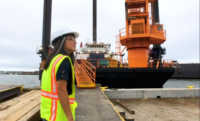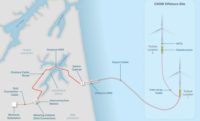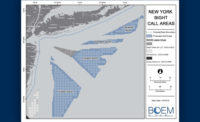Military's Issues With Offshore Wind Farms Now Added to U.S. Spending Bills

Maryland enacted into law on May 22 a commitment to add 1,200 MW of offshore wind to its 50% clean energy goal by 2030
Credit: Rendering, courtesy of Maryland Energy Administration
The U.S. military has been eyeing America’s offshore wind development, concerned about impacts on training and operations, with project-siting issues brewing in some states. The dispute moved to the national stage May 21 when a House of Representatives committee passed federal appropriations bills that would set new curbs on where turbines could go. Industry advocates say they are duplicative impact mandates.
The House Appropriations Committee approved an amendment to fiscal 2020 spending bills for the U.S. Defense and Interior departments to require more National Oceanic and Atmospheric Administration study of turbine construction and operations impacts on marine life.
Introduced by Rep. Andy Harris (R-Md.), it also says wind turbines in large arrays may interfere with radar and underwater sonar, and directs DOD to issue a report next year to address possible national security issues.
The amendment comes as Maryland enacted on May 22 a bill to raise its offshore wind commitment by up to 1,200 MW.
“Some in Congress continue to seek to sow conflict between offshore energy development and military operations,” said Randall Luthi, National Ocean Industries Association president. He said developers and DOD have long worked “with NATO allies in the North Sea.”
The U.S. Bureau of Ocean Energy Management, which leases offshore tracts, now awaits U.S. Navy comment on proposed wind farm projects at several sites off California. Navy officials tell ENR it does not have a timeframe for submitting comments but continues to work with BOEM to find “compatible solutions to offshore wind.”
In North Carolina, new legislation would bar wind farm construction at certain offshore and onshore sites to protect military test flight airspace.
It “falls short” in protecting state military bases and if passed, “would hurt our economy,” says Katherine Kollins, president of the Southeastern Wind Coalition. Navy officials, who would not comment on the bill, said they work with all state entities to review offshore wind proposals in training and test areas.
BOEM published in April a biological assessment for the 800-MW wind farm set to start construction later this year off Rhode Island and Massachusetts, to be operational by 2021. Mitigation steps the agency seeks are included in the project’s construction and operation plan.





